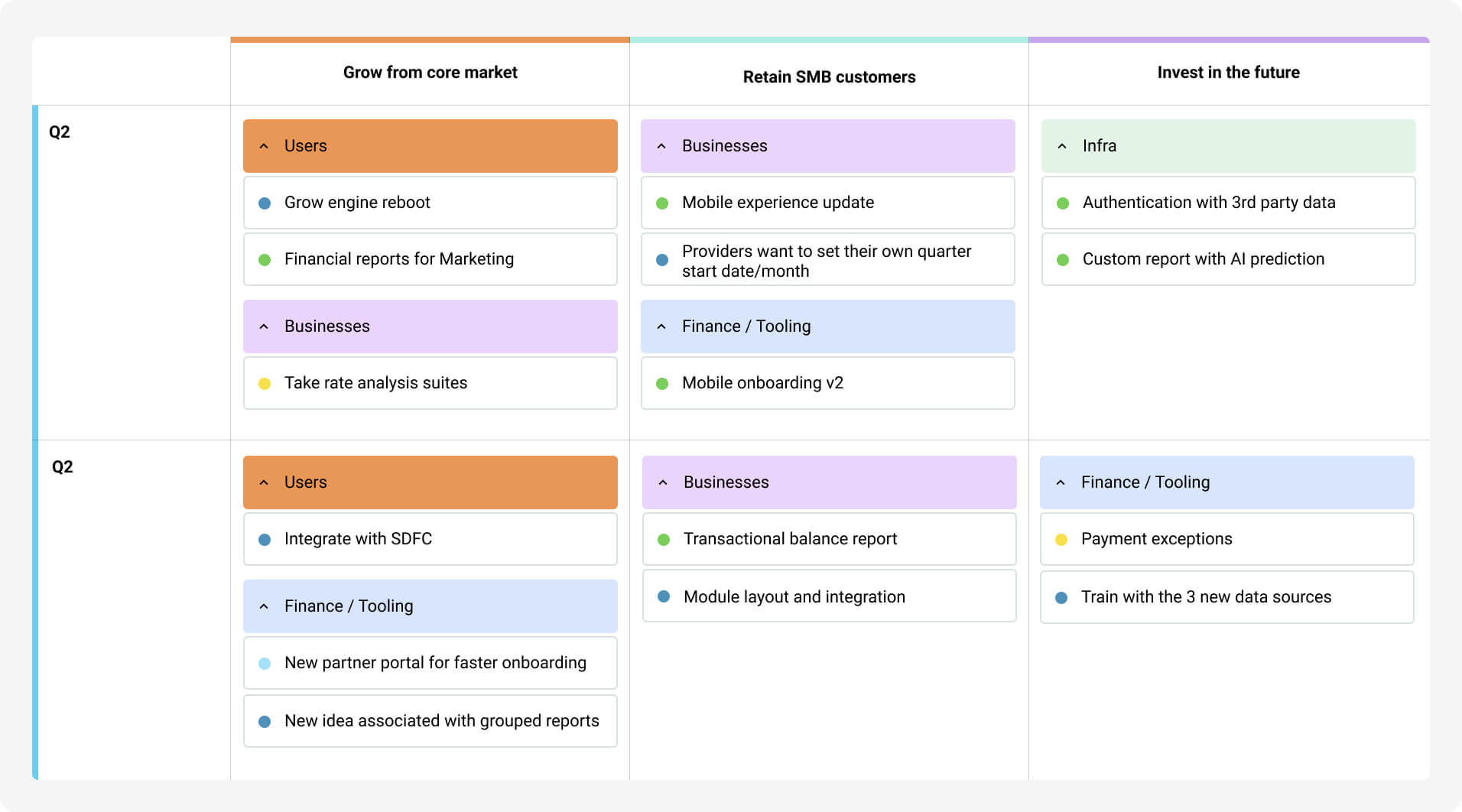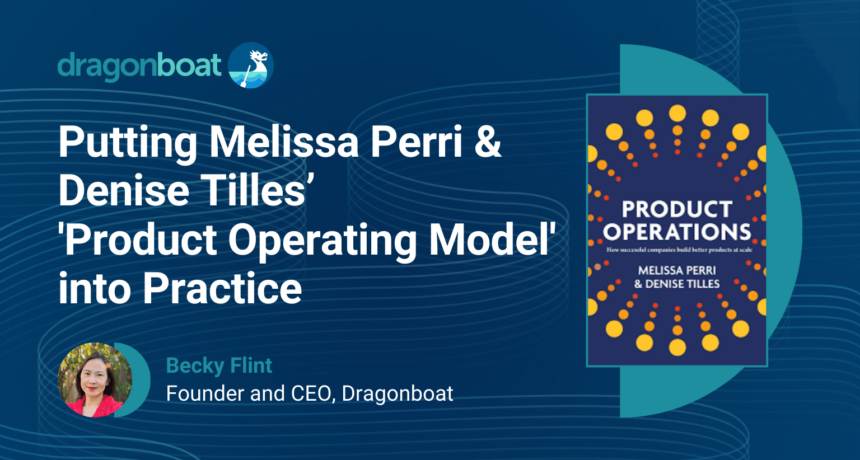In our recent webinar, we explored the transformative power of Product Operations, drawing on the expertise of industry leaders and the foundational concepts from Melissa Perri’s and Denise Tilles’ seminal book “Product Operations: How successful companies build better products at scale”.
Click here to buy your copy of the “Product Operations” book.
Becky Flint, a founding member of PayPal’s Product Ops team in the early 2000s, shared insights into Product Operating Models. Combining the principles outlined in the book and her hands-on experience in building and improving these models, she discussed practical strategies. She also highlighted best practices gleaned from the experiences of thousands of Dragonboat customers, emphasizing how to translate theory into actionable steps to build effective product organizations.
Let’s dive in!
What Are the Three Pillars of Product Operations?
- Data Insights – The ability to make informed decisions is crucial. Having access to and using data insights ensures that every product decision is backed by solid evidence.
- Customer and Market Insights – Keeping your team close to the voice of the customer and market trends helps product teams stay competitive and relevant. This pillar describes building a system to bring these insights to your teams and transform how products are developed.
- Processes and Practices – Cross-team collaboration is key to removing operational barriers. For product teams to succeed in cross-functional work, company processes must enable teams to work effectively, reduce time-to-market, and foster innovation.
What Is the Product Operating Model?
According to Melissa Perri and Denise Tilles, the Product Operating Model is how teams translate business and product strategies into actionable outcomes. It’s about setting the principles, culture, and values that guide the product team’s operations, aligning everyone towards common goals.
This model plays a crucial role in defining processes and governance, ensuring the product team’s work is not only efficient but also strategically aligned with the company’s objectives.
How Product Operations Can Help Implement the Product Operating Model?
Product Operations teams can help their respective teams and organizations implement the Product Operating Model by improving, supporting, or providing various activities related to three major processes:
- Strategic Roadmapping
- Product Roadmapping
- Delivery Review
1. Strategic Roadmapping
Strategic roadmapping is a crucial process for aligning your product strategy with overarching business goals, performed mainly by executives and product leaders. The participation of the product operations team in the following main activities ensures that all work is focused on achieving meaningful outcomes.
Centralize Data and Metrics
Begin by evaluating the current state of your data. Are your metrics scattered across various tools? The goal here is not merely to hit revenue targets, but to understand the specific actions and objectives required to achieve your key metrics.
Align Product Goals With Business Goals
Ensure that all product goals directly support and drive towards the business’s broader objectives, and that all product initiatives contribute to the company’s success. This alignment is essential for cohesive growth.

Set / Align Strategic Intent With Stakeholders
Set a clear connection between your strategic intent and your product goals. Your strategic intent should serve as the guiding light for your product strategy, reflecting the long-term vision and direction.
Set / Align Target Allocations (Portfolio Allocations)
For organizations with more than ten product managers, set goals across various layers, (e.g. company-wide, overall product, and individual product).
Ensure that sufficient resources are allocated to these goals to avoid setting up for failure. In this step, you link all levels of goals with the specific items on your roadmap.

Communicate to Guide Portfolio and Product Roadmapping
Effective communication is key to guiding the strategic direction of your portfolio and individual product roadmaps. This ensures that all stakeholders are on the same page and working towards common objectives.
Output
The culmination of strategic roadmapping activities is a set of clearly defined goals, complete with measurable metrics and allocation figures across all relevant levels (company, product, and team). This output, typically overseen by executives and product leaders, serves as a comprehensive blueprint for strategic execution.
2. Product Roadmapping
Product roadmapping is an ongoing process of translating product goals and metrics into actionable plans that drive progress and success, achieved through the following key activities:
Set Product Goals and Metrics
Every product roadmap starts with clear product goals and associated metrics. As the Product Operations team or function, ensure that the goals and metrics are consistently informed by customer feedback and market research, to ensure that the roadmap is aligned with user needs and business objectives.
Evaluate Product Performance
Supply the data reporting and standards for product teams need to regularly assess how well the product is performing against these objectives, and where improvement is needed.
Prioritize and Plan
Enforce a robust prioritization framework, which helps product teams focus efforts on where they can make the most impact. This ensures that the most valuable features and updates are achieved first.

Evaluate Trade-Offs
Help Product Managers evaluate trade-offs within the context of goal performance and target allocations, making decisions that best align with strategic priorities.

Outputs
The outputs from product roadmapping activities are roadmaps, performance reporting, and communication plans, all of which product operations can support or take on:
- Roadmaps – The product roadmap is the visual representation of the strategy and plan of action for achieving the product goals. It outlines the priorities and timelines for feature releases, updates, and other key initiatives.
- Product Performance Reporting – Regular reporting on product performance is vital for keeping stakeholders informed about progress towards goals. These reports should highlight achievements, challenges, and areas for focus.
- Communication Plans – Effective communication with internal teams, external partners, and executive stakeholders is critical. Developing a plan for how and when to communicate roadmap updates and performance insights ensures everyone is aligned and informed.
3. Delivery Review
Delivery review is a critical phase in the product development lifecycle that ensures alignment and health of the product delivery process. This weekly or biweekly review involves multiple stakeholders, including those responsible for Go-To-Market (GTM) strategies, and focuses on evaluating the progress and efficacy of product delivery.
Here are the key activities that Product Operations can leverage for a successful delivery review:
Engage Full PDLC and GTM Stakeholders
Bring together stakeholders from across the PDLC, including GTM teams, for a holistic view of the product delivery process from initial conception to market launch. This fosters alignment on product strategy, messaging, and launch plans.

Review Roadmap Delivery Status
Assessing how well the product delivery aligns with the established roadmap: report on the status of current projects, milestones achieved, and whether the product development is on track to meet its targets.
Review Delivery Health
Beyond the roadmap status, evaluate and report on overall health of the delivery process: resource allocation, team performance, development challenges, and any bottlenecks that could impede progress.

Check out Four Portfolio Risks Every Product Leader Must Address.
Stakeholder Reporting
- For internal stakeholders, provide regular updates including current status, challenges, and next steps to maintain transparency and foster collaboration.
- For external stakeholders, keep them informed about development progress and roadmap changes to manage expectations and maintain trust.
- Executive stakeholders need concise and focused updates, including achievements, challenges, and strategic adjustments to the roadmap. This secures ongoing support and resources.

Check out 3 Reports Every Product Leader Needs to Share.
Transforming Product Operations: The Path Forward
Becky Flint’s insights underscore the importance of a cohesive product operations model within the workflows of modern product teams.
By concentrating on data and customer insights, improving processes, and following a strong Product Operating Model, Product Operations can greatly boost their efficiency and the overall impact of your product organization.
Effective tools play a vital role in facilitating these best practices. Dragonboat’s product portfolio management platform is specifically designed to tackle the challenges discussed. The principles outlined in the webinar are universally applicable, and we encourage teams to consider implementing these strategies within their own contexts to drive success.
For those interested in seeing how Dragonboat can directly support the implementation of these practices, we invite you to schedule a demo with one of our product experts. Discover firsthand how it transforms your product operations, enabling your team to achieve its goals more efficiently and effectively.
Your Experiences Matter
We’re keen to hear all about your journey in Product Operations. Share your experiences, challenges, and successes in the Product Ops HQ Slack. Let’s continue the conversation and learn from each other, building a community of product professionals committed to excellence and innovation.
[elementor-template id=”12730″]



